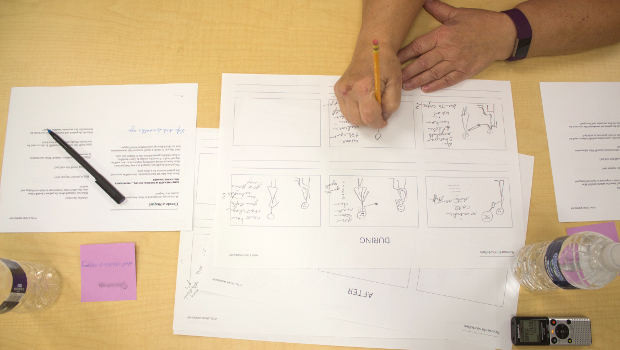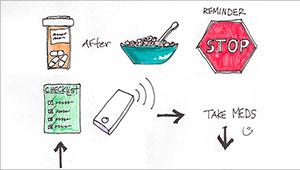Health Informatics
Research overview
Research on health informatics at Kaiser Permanente Washington focuses on developing and using health information technology (IT) to transform health care delivery. By testing new paradigms of care that provide more opportunities to engage patients, this research is supplying valuable evidence that is helping shape federal policy and guiding innovative redesign of health care.
“We’re working to understand how to make health IT practical so patients and care teams find it useful and engaging,” explained Kaiser Permanente Washington Health Research Institute (KPWHRI) Senior Investigator James Ralston, MD, MPH. “We want to find ways to use information technologies to support patients and providers together, both inside and outside the office.”
Integral to this support is designing technologies that are user-friendly and meet the needs of both patients and providers. By applying human-centered methods that focus on needs, use, and usability, KPWHRI researchers inform the design of health IT with direct participation from users.
Groundbreaking methodological work by KPWHRI health informatics researchers includes developing natural language processing (NLP) to analyze text such as notes and written reports in electronic health records (EHRs). Assistant Investigator David Carrell, PhD, leads in the area of using NLP and machine learning to identify patient phenotypes, or specific health characteristics such as possible heart disease, risk of opioid overdose, or suggestion of colon cancer. This information can assist researchers in studying how genetics and other factors influence disease.
Other examples of KPWHRI health informatics research include projects using EHRs and secure electronic communications such as:
- using a patient-shared EHR to improve care for chronic illnesses such as depression, diabetes, hypertension, and heart disease;
- understanding the effects of technologies such as OpenNotes, which gives patients access to notes that their doctors write during office visits;
- understanding and addressing differences in patient use of online health care services that could lead to disparities in care;
- testing NLP to target mentions of specific words and phrases in EHRs to supplement or replace skilled chart abstraction—providing faster access to “big data” and actionable information about patients who may need follow up.
Examples of KPWHRI research in mobile health (mHealth) and user-centered design include:
- evaluating mHealth smartphone tools: 1) to improve primary care for alcohol use disorders, 2) to support patients after bariatric surgery, and 3) to change smoking behavior;
- the VITAL and Seeing Priorities studies to apply user-centered processes to learn how health care providers can elicit and honor what is most important to patients living with multiple chronic health conditions;
- the REMIND project applying user-centered methods to redesign clinical reminders and notifications for patients with chronic and preventive health care needs;
- the landmark Electronic Communications and Blood Pressure (eBP) study of home blood pressure monitoring and web-based care to increase hypertension control without office visits.
“Our studies on using health IT to improve care are showing that we can achieve better outcomes when we shift care from the doctor’s office to where people live: in their homes—and online,” said Senior Investigator Beverly B. Green, MD, MPH.
Recent publications on Health Informatics
Yeung K, Dorsey CN, Mettert K. Effect of new Medicare enrollment on health, healthcare utilization, and cost: a scoping review. J Am Geriatr Soc. 2021 Mar 15. doi: 10.1111/jgs.17113. [Epub ahead of print]. PubMed
Li M, Yeung K. Managing high-priced biologic agents: challenges and potential solutions. J Manag Care Spec Pharm. 2021;27(3):411-414. doi: 10.18553/jmcp.2021.27.3.411. PubMed
Nakandala S, Jankowska MM, Tuz-Zahra F, Bellettiere J, Carlson J, LaCroix AZ, Hartman SJ, Rosenberg D, Zou J, Kumar A, Natarajan L. Application of convolutional neural network algorithms for advancing sedentary and activity bout classification. J Meas Phys Behav. 2021 Jun;4(2):102-110. doi: 10.1123/jmpb.2020-0016. Epub 2021 Feb 25. PubMed
Fitzpatrick SL, Banegas MP, Kimes TM, Papajorgji-Taylor D, Fuoco MJ. Prevalence of unmet basic needs and association with diabetes control and care utilization among insured persons with diabetes. Popul Health Manag. 2021 Aug;24(4):463-469. doi: 10.1089/pop.2020.0236. Epub 2021 Feb 3. PubMed
Bann MA, Carrell DS, Gruber S, Shinde M, Ball R, Nelson JC, Floyd JS. Identification and validation of anaphylaxis using electronic health data in a population-based setting. Epidemiology. 2021 Feb 2. doi: 10.1097/EDE.0000000000001330. [Epub ahead of print]. PubMed
Researchers in Health Informatics
 Claire Allen, MPHManager, Collaborative Science |
 Katharine A. Bradley, MD, MPHSenior Investigator |
 Yates Coley, PhDAssociate Biostatistics Investigator |
 Beverly B. Green, MD, MPHSenior Investigator |
 Annie Hoopes, MD, MPHAssistant Investigator |
 Paula Lozano, MD, MPHSenior Investigator; Director, ACT Center |
 James D. Ralston, MD, MPHSenior Investigator |
 Brian D. Williamson, PhDAssistant Biostatistics Investigator |









